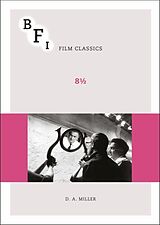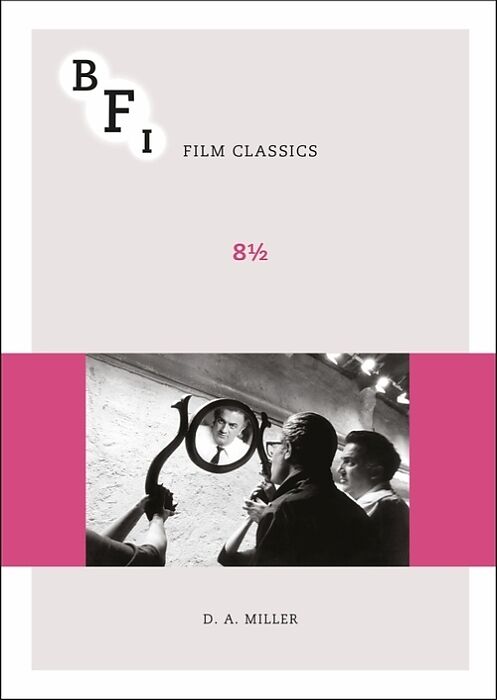Eight and a Half (Otto e mezzo)
Einband:
Broschiert
EAN:
9781844572311
Genre:
Art
Autor:
D A Miller
Herausgeber:
British Film Institute
Erscheinungsdatum:
18.06.2008
Zusatztext ...an excellent addition to one of the finest collections of film criticism ever collated...He [Miller] makes an interesting and persuasive argument for his theory and! like much great criticism! sheds new light on a classic film. Informationen zum Autor D.A. Miller is John F. Hotchkis Professor in English at the University of California! Berkeley! USA. He writes a regular column for 'Film Quarterly'. Klappentext Federico Fellini's masterpiece 8 1/2 (Otto e mezzo) shocked audiences around the world when it was released in 1963 by its sheer auteurist gall. The hero! a film director named Guido Anselmi! seemed to be Fellini's mirror image! and the story to reflect the making of 8 1/2 itself. Whether attacked for self-indulgence or extolled for self-consciousness! 8 1/2 became the paradigm of personal filmmaking! and numerous directors! including Martin Scorsese! Woody Allen and Bruce LaBruce! paid homage to it in their own work. Now that 8 1/2's conceit is less shocking! D.A. Miller argues! we can see more clearly how tentative! even timid! Fellin's ground-breaking incarnation always was. Guido is a perfect blank! or is trying his best to seem one. By his own admission he doesn't even have an artistic or social statement to offer: 'I have nothing to say! but I want to say it anyway.' 8 1/2's deepest commitment is not to this man (who is never quite 'all there') or to his message (which is lacking entirely) but to its own flamboyant manner. The enduring timeliness of 8 1/2 lies! Miller suggests! in its aggressive shirking of the shame that falls on the man - and the artist - who fails his appointed social responsibilities. Zusammenfassung Federico Fellini's masterpiece 8 1/2 (Otto e mezzo) shocked audiences around the world when it was released in 1963 by its sheer auteurist gall. The hero, a film director named Guido Anselmi, seemed to be Fellini's mirror image, and the story to reflect the making of 8 1/2 itself. Whether attacked for self-indulgence or extolled for self-consciousness, 8 1/2 became the paradigm of personal filmmaking, and numerous directors, including Martin Scorsese, Woody Allen and Bruce LaBruce, paid homage to it in their own work.Now that 8 1/2's conceit is less shocking, D.A. Miller argues, we can see more clearly how tentative, even timid, Fellin's ground-breaking incarnation always was. Guido is a perfect blank, or is trying his best to seem one. By his own admission he doesn't even have an artistic or social statement to offer: 'I have nothing to say, but I want to say it anyway.' 8 1/2's deepest commitment is not to this man (who is never quite 'all there') or to his message (which is lacking entirely) but to its own flamboyant manner. The enduring timeliness of 8 1/2 lies, Miller suggests, in its aggressive shirking of the shame that falls on the man and the artist who fails his appointed social responsibilities. Inhaltsverzeichnis Prologue1. From No One to Someone2. From Auteur to Person3. From Substance to StyleFinaleAcknowledgmentsNotesCredits ...
Autorentext
D.A. Miller is John F. Hotchkis Professor in English at the University of California, Berkeley, USA. He writes a regular column for 'Film Quarterly'.
Klappentext
Federico Fellini's masterpiece 8 1/2 (Otto e mezzo) shocked audiences around the world when it was released in 1963 by its sheer auteurist gall. The hero, a film director named Guido Anselmi, seemed to be Fellini's mirror image, and the story to reflect the making of 8 1/2 itself. Whether attacked for self-indulgence or extolled for self-consciousness, 8 1/2 became the paradigm of personal filmmaking, and numerous directors, including Martin Scorsese, Woody Allen and Bruce LaBruce, paid homage to it in their own work.
Now that 8 1/2's conceit is less shocking, D.A. Miller argues, we can see more clearly how tentative, even timid, Fellin's ground-breaking incarnation always was. Guido is a perfect blank, or is trying his best to seem one. By his own admission he doesn't even have an artistic or social statement to offer: 'I have nothing to say, but I want to say it anyway.' 8 1/2's deepest commitment is not to this man (who is never quite 'all there') or to his message (which is lacking entirely) but to its own flamboyant manner. The enduring timeliness of 8 1/2 lies, Miller suggests, in its aggressive shirking of the shame that falls on the man - and the artist - who fails his appointed social responsibilities.
Inhalt
Prologue 1. From No One to Someone 2. From Auteur to Person 3. From Substance to Style Finale Acknowledgments Notes Credits

Leider konnten wir für diesen Artikel keine Preise ermitteln ...
billigbuch.ch sucht jetzt für Sie die besten Angebote ...
Die aktuellen Verkaufspreise von 6 Onlineshops werden in Realtime abgefragt.
Sie können das gewünschte Produkt anschliessend direkt beim Anbieter Ihrer Wahl bestellen.
Loading...
Die aktuellen Verkaufspreise von 6 Onlineshops werden in Realtime abgefragt.
Sie können das gewünschte Produkt anschliessend direkt beim Anbieter Ihrer Wahl bestellen.
| # | Onlineshop | Preis CHF | Versand CHF | Total CHF | ||
|---|---|---|---|---|---|---|
| 1 | Seller | 0.00 | 0.00 | 0.00 |
